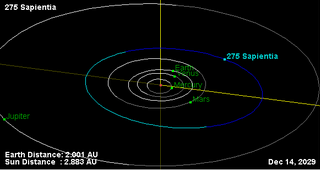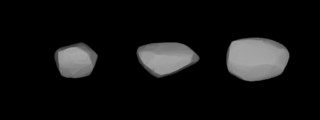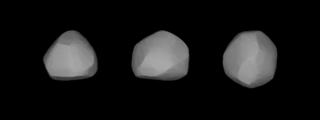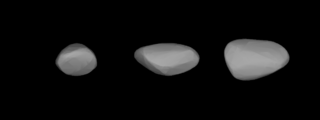Related Research Articles

191 Kolga is a large, dark main-belt asteroid that was discovered by German-American astronomer C. H. F. Peters on September 30, 1878, in Clinton, New York. It is named after Kólga, the daughter of Ægir in Norse mythology.

Ambrosia is a main belt asteroid that was discovered by the Corsican-born French astronomer J. Coggia on February 28, 1879, and named after Ambrosia, the food of the gods in Greek mythology.

Atropos is a typical Main belt asteroid that was discovered by Austrian astronomer Johann Palisa on 8 March 1888 in Vienna.

Sapientia is a very large Main belt asteroid that was discovered by Johann Palisa on 15 April 1888 in Vienna. It is classified as a C-type asteroid and is probably composed of carbonaceous material. It is named for the Roman personification of wisdom, Sapientia.
Cheruskia is a minor planet, specifically an asteroid orbiting in the asteroid belt that was discovered by German astronomer Paul Götz on 26 July 1905 from Heidelberg.

Recha is a minor planet, specifically an asteroid orbiting in the asteroid belt between Mars and Jupiter. The asteroid, discovered by German astronomer Max Wolf on September 19, 1905, was named after a character in Gotthold Ephraim Lessing's play Nathan the Wise and may have been inspired by the asteroid's provisional designation 1905 RC.
Renate is a minor planet, specifically an asteroid orbiting in the asteroid belt which was discovered by German astronomer Max Wolf on September 19, 1905. The name may have been inspired by the asteroid's provisional designation 1905 RE.

Rebekka is a minor planet orbiting the Sun, which was discovered on September 19, 1905, by a German astronomer Paul Götz in Heidelberg. It was named after a young lady from Heidelberg, and may have been inspired by the asteroid's provisional designation 1905 RB.
Bilkis is a minor planet, specifically an asteroid orbiting in the asteroid belt. It was discovered by German astronomer August Kopff in 1906 February and was given the Koran name for the Queen of Sheba. Photometric observations at the Palmer Divide Observatory in Colorado Springs, Colorado in 2006–7 were used to build a light curve for this object. The asteroid displayed a rotation period of 8.5742 ± 0.0005 hours and a brightness variation of 0.40 ± 0.02 in magnitude.

Juvisia is a minor planet, specifically an asteroid orbiting in the asteroid belt that was discovered 27 August 1906 in Heidelberg by German astronomer Max Wolf. It was named after the commune Juvisy-sur-Orge, France, where French astronomer Camille Flammarion had his observatory.
607 Jenny is a minor planet, specifically an asteroid orbiting in the asteroid belt that was discovered by German astronomer August Kopff on September 18, 1906.
639 Latona is a minor planet, specifically an asteroid orbiting in the asteroid belt. It was discovered by German astronomer Karl Lohnert on July 19, 1907, at Heidelberg.
687 Tinette is a minor planet, specifically an asteroid orbiting primarily in the asteroid belt. It was discovered by Austrian astronomer Johann Palisa on 16 August 1909 from Vienna and was given the preliminary designation 1909 HG.

708 Raphaela is a minor planet orbiting the Sun.

747 Winchester is an asteroid, a minor planet orbiting the Sun. It was discovered in 1913, and is named after the town in which it was discovered, Winchester, Massachusetts, in the USA.

787 Moskva is a minor planet orbiting the Sun. It is a dynamic member of the Maria asteroid family orbiting near the 3:1 Kirkwood gap. This is an S-type (stony) asteroid spanning 27 km. The surface mineralogy is consistent with mesosiderite silicates.
793 Arizona is a minor planet orbiting the Sun that was discovered April 9, 1907 by American businessman Percival Lowell at Flagstaff. It was named for the state of Arizona. The object was independently discovered on April 17, 1907, by J. H. Metcalf at Taunton. This is a main belt asteroid orbiting 2.8 AU from the Sun with a period of 4.675 yr and an eccentricity (ovalness) of 0.13. The orbital plane is inclined at an angle of 15.8° to the plane of the ecliptic.
840 Zenobia is a minor planet orbiting the Sun. It was discovered by German astronomer Max Wolf at Heidelberg on September 25, 1916. The origin of the name is uncertain, but it may be named after the Slavic god of the hunt.
947 Monterosa is a minor planet orbiting the Sun.
7816 Hanoi, provisional designation 1987 YA, is an eccentric stony asteroid and Mars-crosser from the inner regions of the asteroid belt, approximately 3 kilometers in diameter. It was discovered on 18 December 1987, by Japanese astronomer Masahiro Koishikawa at the Ayashi Station of the Sendai Astronomical Observatory, Japan, and later named after the Vietnamese capital of Hanoi.
References
- 1 2 "620 Drakonia (1906 WE)". JPL Small-Body Database . NASA/Jet Propulsion Laboratory . Retrieved 5 May 2016.
- 1 2 Warner, Brian D. (January 2011), "Upon Further Review: IV. An Examination of Previous Lightcurve Analysis from the Palmer Divide Observatory", The Minor Planet Bulletin, vol. 38, no. 1, pp. 52–54, Bibcode:2011MPBu...38...52W.
- ↑ Schmadel, Lutz D. (2012), Dictionary of Minor Planet Names (6th ed.), Springer, p. 61, ISBN 3642297188.